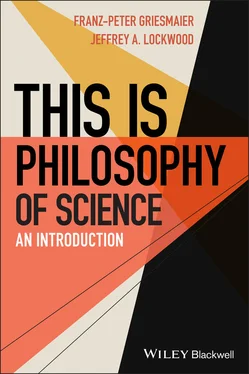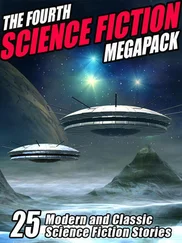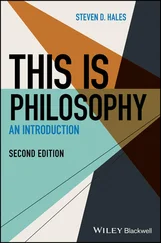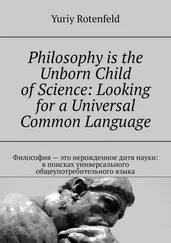Franz-Peter Griesmaier - This is Philosophy of Science
Здесь есть возможность читать онлайн «Franz-Peter Griesmaier - This is Philosophy of Science» — ознакомительный отрывок электронной книги совершенно бесплатно, а после прочтения отрывка купить полную версию. В некоторых случаях можно слушать аудио, скачать через торрент в формате fb2 и присутствует краткое содержание. Жанр: unrecognised, на английском языке. Описание произведения, (предисловие) а так же отзывы посетителей доступны на портале библиотеки ЛибКат.
- Название:This is Philosophy of Science
- Автор:
- Жанр:
- Год:неизвестен
- ISBN:нет данных
- Рейтинг книги:5 / 5. Голосов: 1
-
Избранное:Добавить в избранное
- Отзывы:
-
Ваша оценка:
- 100
- 1
- 2
- 3
- 4
- 5
This is Philosophy of Science: краткое содержание, описание и аннотация
Предлагаем к чтению аннотацию, описание, краткое содержание или предисловие (зависит от того, что написал сам автор книги «This is Philosophy of Science»). Если вы не нашли необходимую информацию о книге — напишите в комментариях, мы постараемся отыскать её.
This is Philosophy of Science
This Is Philosophy???
, This is Philosophy of Science: An Introduction
This is Philosophy of Science — читать онлайн ознакомительный отрывок
Ниже представлен текст книги, разбитый по страницам. Система сохранения места последней прочитанной страницы, позволяет с удобством читать онлайн бесплатно книгу «This is Philosophy of Science», без необходимости каждый раз заново искать на чём Вы остановились. Поставьте закладку, и сможете в любой момент перейти на страницу, на которой закончили чтение.
Интервал:
Закладка:
For example, if I infer, on the basis of having observed the eating habits of 20 koalas, that all koalas eat eucalyptus leaves, I make such a risky inference. I assume, among other things, that the koalas I observed are typical of their species. This assumption could easily be wrong, as I might have come across a peculiar band of koalas that happen to consume eucalyptus. That such inferences are risky, however, doesn’t show that they are altogether unreasonable. The conditions under which they are reasonable are somewhat difficult to pin down, and we will tackle this challenge in the next section.
Now, given that reasoning nondeductively is risky, and that the conditions of its reasonableness are somewhat elusive, one might think that science should aim at just using deductive inferences, precisely because they are safe – even certain. But that would be a mistake. Remember: They are safe because in an important sense, they are uninformative. Since there is no new information in a deductive conclusion that was not already implicitly contained in the premises, deductive inferences won’t allow you to gain more information about the world by reasoning from your evidence. To accomplish this, we need to go beyond an obsession with certainty, which is provided by conclusive reasons and reasoning, and enlarge our toolbox. The tools we need, especially for the empirical sciences, are various forms of defeasible reasoning, and thus defeasible reasons .
1.1.2 Defeasible Reasons
The second, and much more common, type of epistemic reasons are called defeasible reasons. They are also sometimes called probable , or prima facie reasons. The main difference between these and conclusive reasons is that even true defeasible reasons don’t guarantee the truth of their target belief. Consider this example:
You are near the mouth of a cave looking at a rock formation just inside the cave. The formation looks red to you. This “red-looking” is a good (defeasible) reason for believing that the rocks are red. However, as we all know, lighting conditions vary in natural settings and can be deceptive. Thus, it could be the case that the rock formation isn’t really red; its red appearance could be produced by weird lighting filtering into the cave. Thus, although the red-appearance of the formation is a good defeasible reason for believing it to be red, the truth of this latter belief is not guaranteed.
What defeasible reasons do is to make the truth of the belief for which they are reasons probable . (That’s why they are also called probable reasons.) A red appearance of a rock formation makes it more probable that the formation is red than that it is not. Of course, you could acquire a further bit of information which defeats the strength of the reason (that’s why they are called defeasible reasons). For example, you could notice that there is a brilliant sunset outside the cave, which makes it likely that many even nonred things look red. Thus, the fact that the formation looks red to you is no longer a very good reason for believing that it is actually red, given that many nonred things will seem to be red in these lighting conditions.
There are actually two recognized kinds of defeating information, or defeaters: so-called rebutting defeaters and undercutting defeaters . In the example just given, noticing that there is a sunset is an undercutting defeater. It undercuts the evidential force of your original reason for believing that the formation is red. Given that you know of the red lighting, you now can’t fully trust that things have the color which they seem to have. Of course, the rocks could still be red. But you would need to illuminate them with a white light or take a sample and observe it during daylight to make sure. On the other hand, it could also be the case that a geologist tells you that the formation isn’t red, because there are no rocks of this color in the region. To the extent that you can trust her, you now have a rebutting defeater for your belief that the formation is red.
As mentioned above, defeasible reasons constitute the vast majority of the reasons we have for believing something. Conclusive reasons are limited to mathematics and logic. It is therefore extremely important to remember that talk of “physical proof,” for example, is a misunderstanding of the concept, if “proof” is being used with its technical meaning. A proof consists in providing conclusive reasons for some target belief. That means that it must be literally impossible for the premises (i.e., reasons) to be true and the target belief to be false at the same time. Such high standards of evidence are unavailable in the empirical sciences. We just can’t be certain. Even the best empirical evidence, on the basis of which we can form true premises for an argument, does not guarantee the truth of the target belief (i.e., hypothesis or theory; we’ll explore the difference between these below).
Good evidence makes the supported theory highly probable, often so probable in fact that we may legitimately say that we justifiably assert that it is true. But the truth is not guaranteed by even the best evidence. Thus, there can’t be literally a proof of any empirical belief – not the Big Bang, quantum mechanics, plate tectonics, or evolution. Proof requires conclusive reasons which are limited to mathematics and logic. This seemingly technical point is borne out by the history of science. Most, if not all, empirical theories of the past have turned out to be strictly speaking false, even though many were in the right ballpark and much better than the alternatives. Had the evidence used to support them guaranteed their truth, they couldn’t have turned out false. But they did. Let’s look at the infamous “substance” caloric , the stuff heat is allegedly made of – a once entirely reasonable and well-supported hypothesis that was ultimately wrong.
There was once good evidence for the theory that heat is a sort of subtle fluid, exchanged between bodies. This fluid was called “caloric.” We still use the term “calories,” which derives from that old theory of heat. It was partially based on the observation that if two objects at different temperatures are in contact, they will eventually reach thermal equilibrium: the hotter object will cool off and the cooler object will heat up, until they both have the same temperature. This looks a lot like what happens when one opens the valve of a hose connecting two buckets that hold different amounts of water. The water will run from the bucket with more water to the other one, until both hold the same amount of water. If heat was also a fluid, we would have a good explanation of the fact that adjacent bodies eventually reach thermal equilibrium. So based on this evidence and reasoning from what seemed to be an analogous system, scientists inferred that heat is such a fluid and called it caloric.
Of course, now we know that heat is, roughly speaking, micromotion or the movement of unobservably small particles (atoms and molecules). This understanding arose from the production of canons in the eighteenth century. 1Using a cold drill to bore a hole into cold metal produced a lot of heat. But where was the heat coming from? Caloric was assumed to be a conserved quantity that could only be redistributed among objects, but neither created nor destroyed. The “new” heat from the canons was tantamount to running a hose between two half-full buckets and having them both overflow. You might think that this problem would’ve been apparent from other instances of friction, but the phenomenon was dramatically evident in the manufacturing of canons. What this episode shows is that even good evidence for a theory provides at best a defeasible reason for accepting that theory. New evidence can force us to retract our theory, exactly like knowledge of weird lighting conditions in a cave can force us to retract our belief about the color of rock formations.
Читать дальшеИнтервал:
Закладка:
Похожие книги на «This is Philosophy of Science»
Представляем Вашему вниманию похожие книги на «This is Philosophy of Science» списком для выбора. Мы отобрали схожую по названию и смыслу литературу в надежде предоставить читателям больше вариантов отыскать новые, интересные, ещё непрочитанные произведения.
Обсуждение, отзывы о книге «This is Philosophy of Science» и просто собственные мнения читателей. Оставьте ваши комментарии, напишите, что Вы думаете о произведении, его смысле или главных героях. Укажите что конкретно понравилось, а что нет, и почему Вы так считаете.












